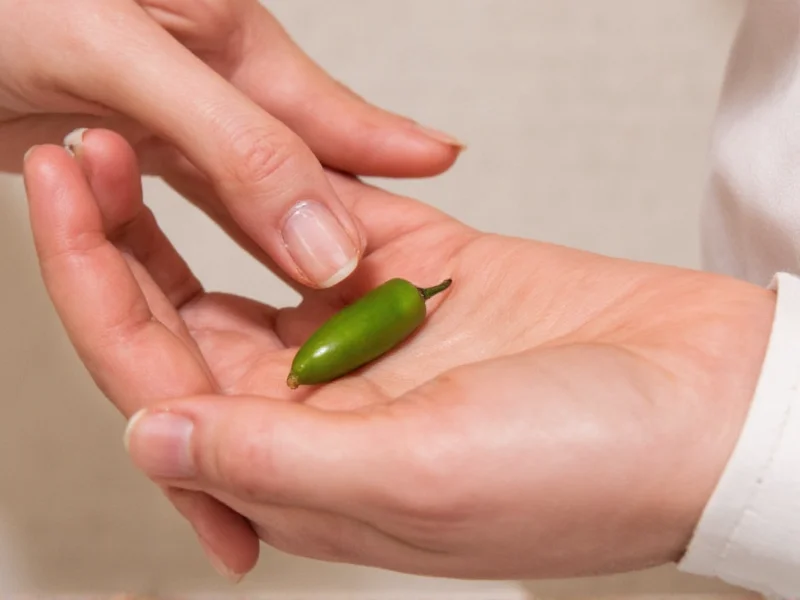When handling jalapeños, the capsaicin oil penetrates your skin, causing that familiar burning sensation that water alone can't remove. Understanding why standard washing fails is key to finding effective solutions. Capsaicin, the compound responsible for the heat in chili peppers, is hydrophobic—meaning it repels water but dissolves in fats, oils, and alcohol. This explains why rinsing with water often spreads the oil while intensifying the burn.
Why Water Doesn't Work for Jalapeño Oil Removal
Water's molecular structure can't break down capsaicin's oily compounds. In fact, using hot water may open your pores further, allowing more capsaicin to absorb into your skin. The persistent burning occurs because capsaicin binds to TRPV1 receptors in your skin—the same receptors that detect actual heat. This neurological trick makes your brain perceive continuous burning even after handling the peppers.
Most Effective Methods to Remove Jalapeño Oil
Based on capsaicin's chemical properties, these methods provide the fastest relief by either dissolving the oil or neutralizing its effects:
| Method | Effectiveness | Time Required | Key Benefit |
|---|---|---|---|
| Dish soap + rubbing alcohol | ★★★★★ | 5-10 minutes | Breaks down oil molecules |
| Milk soak | ★★★★☆ | 10-15 minutes | Casein protein neutralizes capsaicin |
| Vegetable oil | ★★★☆☆ | 5 minutes | Dissolves capsaicin through oil-on-oil action |
| Baking soda paste | ★★★☆☆ | 10 minutes | Gentle abrasive action |
| Commercial pepper wipes | ★★★★☆ | 2-3 minutes | Formulated specifically for capsaicin removal |
Step-by-Step Removal Process
1. Dish Soap and Rubbing Alcohol Method (Most Effective)
This dual-action approach works because dish soap contains surfactants that break down oils, while rubbing alcohol dissolves the capsaicin compounds. Start by washing your hands thoroughly with dish soap and warm water for at least 30 seconds. Then apply rubbing alcohol to a cotton ball and rub it over affected areas for 15-20 seconds before rinsing again. Repeat if necessary. This method for how to get capsaicin off hands works faster than single-ingredient solutions because it addresses both the oily nature of capsaicin and its chemical structure.
2. Dairy-Based Relief (Immediate Soothing)
After using the soap and alcohol method, soak your hands in cold milk for 5-10 minutes. The casein protein in dairy binds to capsaicin and washes it away. Plain yogurt or sour cream applied directly also works well for removing jalapeno burn from skin. This step provides almost instant relief as the casein disrupts the capsaicin-receptor binding. For best results, use whole milk rather than skim, as the fat content helps dissolve the oil more effectively.
3. Oil-Based Transfer Technique
If you don't have alcohol available, use the oil-on-oil principle to remove jalapeño oil. Apply vegetable oil, olive oil, or even peanut butter to your hands and rub thoroughly for 2 minutes before washing with soap. The capsaicin dissolves into the applied oil, which you then wash away. This method works because "like dissolves like" – the oil-based capsaicin transfers to the new oil rather than remaining on your skin. It's particularly useful when you're trying to stop jalapeno hands from burning while cooking.
What NOT to Do with Jalapeño Oil Exposure
Avoid these common mistakes that worsen the burning:
- Don't use hot water – increases absorption and intensifies burning
- Avoid touching your face – especially eyes, which can cause severe irritation
- Don't rub vigorously – spreads oil and damages skin barrier
- Skip harsh chemicals – bleach or strong solvents can cause chemical burns
Many people mistakenly believe that vinegar helps with jalapeno oil removal home remedies, but its acidity can actually increase skin irritation without effectively breaking down capsaicin.
Prevention Strategies for Future Handling
The best solution for how to prevent jalapeno hands is proper preparation:
- Wear nitrile gloves (latex isn't sufficient as capsaicin penetrates it)
- Use a dedicated cutting board for peppers
- Wash knives and surfaces with soapy water immediately after use
- Keep a bowl of milk nearby when handling hot peppers
Professional chefs often recommend removing seeds and membranes first (where capsaicin concentration is highest) before chopping the pepper body. This jalapeno handling technique significantly reduces oil transfer to your hands.
When to Seek Medical Attention
While most jalapeño burns resolve within hours, consult a healthcare provider if you experience:
- Severe blistering or skin peeling
- Prolonged burning lasting more than 24 hours
- Signs of infection (increased redness, swelling, pus)
- Eye exposure causing vision changes
For eye exposure, flush immediately with saline solution or cool water for 15 minutes. Never use oil-based remedies near eyes as they can worsen irritation.
Scientific Explanation Behind Effective Remedies
The effectiveness of these methods stems from capsaicin's chemical properties. As a lipophilic compound, it dissolves in fats and alcohols but not water. Rubbing alcohol (isopropyl alcohol) breaks the hydrogen bonds holding capsaicin to skin receptors. Dairy products work because casein, a phosphoprotein in milk, acts as a detergent that surrounds and washes away capsaicin molecules. Understanding this science helps explain why certain jalapeno oil removal home remedies succeed while others fail.
Final Thoughts on Jalapeño Oil Removal
Successfully removing jalapeño oil requires understanding its chemical nature and using methods that directly address how capsaicin interacts with your skin. The combination of dish soap, rubbing alcohol, and dairy products provides the most reliable solution for how to get jalapeno oil off hands. Prevention through proper handling techniques remains the best approach, but when accidents happen, these science-backed methods deliver fast, effective relief without damaging your skin. Remember that individual skin sensitivity varies, so what works instantly for one person might require repetition for another – patience and thoroughness yield the best results.











 浙公网安备
33010002000092号
浙公网安备
33010002000092号 浙B2-20120091-4
浙B2-20120091-4